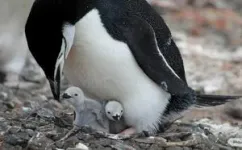(Press-News.org) Researchers have discovered that seabirds, including penguins and albatrosses, have highly-sensitive regions in their beaks that could be used to help them find food. This is the first time this ability has been identified in seabirds.
An international team of researchers, led by the University of Cambridge, studied over 350 species of modern birds and found that seabirds have a high density of sensory receptors and nerves at the tip of their beaks, which has been previously identified in specialised tactile foragers such as ducks.
The researchers say this touch-sensitive region could have come from a common ancestor, and further work is needed to determine whether it serves a specific function in modern birds. Further study of their beaks and food-gathering behaviour could help conserve some of these birds, many of which are at threat of extinction. The results are reported in the journal Biology Letters.
In the same way as humans and other primates use their hands, birds use their beaks to interact with the world around them. Some birds have specialised touch-sensitive areas at the tips of their beaks to help them find food, but since this ability has not been widely studied, it’s not known how the phenomenon evolved or how widespread it is.
“Many scientists had assumed most birds had touch-sensitive beaks, but we hadn’t investigated it enough to know whether it’s a common ability, or whether it’s limited to particular families of birds,” said lead author Dr Carla du Toit from Cambridge’s Department of Earth Sciences.
One group that hasn’t been well studied is the large group of seabirds called Austrodyptornithes, which includes albatrosses, petrels, and penguins. Since many of the bird species in this group are critically endangered, understanding how they find their food using their beaks could be a valuable tool to aid in their conservation.
Du Toit and her colleagues from the UK and South Africa conducted a study of 361 modern bird species, based on fossil and skeletal records, as well as birds that had been accidentally killed by fishing lines and nets. The team focused on the beaks of these birds, how they are constructed and connected to their nerves and blood vessels.
The researchers found that albatrosses and penguins have organs with high density sensory receptors and high concentrations of nerves in their beaks, which is more common in specialised foragers such as ducks. This is the first time that this functionality has been observed in seabirds.
“Seabirds aren’t known to be tactile foragers, so it’s surprising to find that they have this organ,” said du Toit. “It’s really exciting when you get to be the first to see something.”
These touch-sensitive beaks might help seabirds find food at night or underwater, as they might enable the birds to detect tiny vibrations from potential prey. Some birds that are already known to have touch-sensitive beaks use them to detect tiny underground vibrations from worms, for example.
However, these sensitive areas could also be a ‘leftover’ trait from a common ancestor that doesn’t have a specific function in modern birds, like the beaks of ostriches and emus. Further studies in live birds will be needed to establish the exact purpose of these touch-sensitive areas, which may also help determine how the ability evolved.
“In humans and other primates, our sensitive hands and fingers allowed us to master a huge range of environments,” said du Toit. “Beaks are analogous to hands in a way, but this is the first time we’ve seen touch-sensitive beaks in seabirds. It’s remarkable that no one has ever really studied this in detail, considering that we all learn about evolution from the beaks of Darwin’s finches in school.”
The researchers say their findings could potentially play a role in conserving some of these birds. Of the 22 known species of albatross, 15 are threatened with extinction and two are listed as critically endangered. One of the big threats to albatrosses is commercial longline fishing, which kills an estimated 100,000 of the birds per year, when they get tangled in the lines and drown. According to du Toit, if scientists can better understand how these birds get their food, it could be used to help protect them.
“Much further work is needed, but if albatrosses and other seabirds are able to detect vibrations from potential prey via their beaks, it could be possible to attach some sort of device to longlines that could repel them, so they are less likely to get caught,” said du Toit. “Of course, the bigger threats to birds like albatrosses are climate change, rising ocean temperatures, plastic pollution and falling fish stocks, but if there’s a way to reduce the risks to seabirds in even a small way, then that’s incredibly valuable. These are such special birds and I’ve been interested in them for as long as I can remember.”
The research was supported in part by the Royal Society, the Newton International Fellowship, and UK Research and Innovation (UKRI).
END
Highly-sensitive beaks could help albatrosses and penguins find their food
2024-09-18
ELSE PRESS RELEASES FROM THIS DATE:
Self-reporting of health may lead to underestimation of health inequalities in England
2024-09-17
UNDER STRICT EMBARGO UNTIL TUESDAY 17 SEPTEMBER 23:15 UK TIME (BST).
Self-reporting of health may lead to underestimation of health inequalities in England
Peer reviewed | Observational study | People
A first-of-its kind analysis of data collected from England’s annual health survey found that of the people who reported their health as ‘poor’, those living in areas of high deprivation are likely to have worse health than those living in the least deprived areas.
This could mean that we are ...
New research shows how oral cancer cells avoid immune system
2024-09-17
Macquarie University researchers have discovered new information about how oral cancer cells may block the body's immune response. This could lead to better treatments for this aggressive disease.
Their research, published in the Journal of Oral Biosciences this month, looked at protein interactions in oral cancer cells that might stop our immune cells from attacking these tumours.
Oral cancer is the sixth most common cancer in Australia and the most common in India. Advanced forms of oral cancer are hard to treat, with patients typically surviving less than 12 months.
Lead author Dr Rajdeep Chakraborty from Applied Biosciences ...
Abnormal electrolyte levels in people with eating disorders may increase risk of death, poor health outcomes
2024-09-17
Ottawa, ON, September 17, 2024 – A new study published in The Lancet Psychiatry found that 32% of individuals with an eating disorder had abnormal electrolyte levels, which were associated with a higher risk of death from any cause.
The study, led by researchers at ICES and The Ottawa Hospital, found that electrolyte abnormalities were also linked to the development of other serious health conditions, including chronic kidney disease, bone fracture, bowel obstruction, and acute kidney injury.
This is one of the first large, population-based studies to identify an important risk factor for mortality and poor health outcomes in individuals ...
No major concerns about risks to offspring for would-be dads taking epilepsy meds
2024-09-17
Would-be dads taking drugs to stop their epilepsy seizures—and valproate in particular—should be largely reassured that the available evidence on the developmental risks to their offspring doesn’t justify any major concerns, concludes a systematic review of relevant studies published online in the Journal of Neurology Neurosurgery & Psychiatry.
The available evidence is scarce and inconsistent, but most studies indicate no heightened risk, the findings show, casting doubt on the stance taken by the UK drugs regulator, the MHRA, in particular, say ...
Fifth of GPs using AI despite lack of guidance or clear work policies, UK survey suggests
2024-09-17
A fifth of family doctors (GPs) seem to have readily incorporated AI into their clinical practice, despite a lack of any formal guidance or clear work policies on the use of these tools, suggest the findings of an online UK-wide snapshot survey, published in the open access journal BMJ Health & Care Informatics.
Doctors and medical trainees need to be fully informed about the pros and cons of AI, especially because of the inherent risks of inaccuracies (‘hallucinations’), algorithmic biases, and the potential to compromise patient privacy, ...
Novel triplet regimen yields promising response in advanced-phase chronic myeloid leukemia
2024-09-17
HOUSTON ― According to researchers at The University of Texas MD Anderson Cancer Center, 80% of patients with previously untreated or relapsed/refractory advanced-phase chronic myeloid leukemia (CML) – including both accelerated or myeloid blast phases of the disease – or Philadelphia chromosome-positive acute myeloid leukemia (AML) achieved a bone marrow remission when treated with a novel combination of decitabine, venetoclax and ponatinib.
Findings from the Phase II clinical trial, published today in The Lancet Haematology, represent an important step forward for patients ...
‘Scuba-diving’ lizards use bubble to breathe underwater and avoid predators
2024-09-17
BINGHAMTON, N.Y. -- Presenting the world’s smallest (and scrappiest) scuba diver: A species of semi-aquatic lizard produces a special bubble over its nostrils to breathe underwater and avoid predators, according to new research from Binghamton University, State University of New York.
Lindsey Swerk, an assistant research professor of biological sciences at Binghamton University, studies water anoles, a type of semi-aquatic lizard found in the tropical forests of southern Costa Rica. She had previously documented the lizards using a bubble underwater. When these lizards feel threatened by a predator, ...
USC launches large-scale nationwide study of type 1 diabetes and brain development
2024-09-17
About half of adults with type 1 diabetes face significant cognitive impairment, including problems with working memory and executive function that affect day-to-day thinking. But less is known about how the condition affects children during a window of time known to be critical for healthy brain development.
A new large-scale longitudinal study, led by the Keck School of Medicine of USC, will unite 12 research centers across the United States to explore that important question. Researchers will collaborate to recruit a large, diverse group of children newly diagnosed with diabetes, taking a sweeping look at the environmental, lifestyle, ...
Ancestry-specific genetic variants linked to multiple sclerosis risk, new study shows
2024-09-17
A landmark study has uncovered novel ancestry-specific genetic variants linked to multiple sclerosis (MS), offering new insights that could reshape treatment approaches for diverse populations affected by the disease.1 The research, presented today at ECTRIMS 2024, is the result of efforts by the Alliance for Research in Hispanic MS (ARHMS) Consortium and is the first large-scale study to identify ancestry-specific genetic effects for MS risk.
In a comprehensive analysis of over 7,000 individuals from self-reported Hispanic (n=4,313; 2,201 MS, 2,112 controls) and African American (n=3,085; 1,584 MS, 1,501 controls) backgrounds, researchers discovered ...
Early high-efficacy treatment significantly reduces long-term disability in children with multiple sclerosis, new study finds
2024-09-17
New research presented today at ECTRIMS 2024 reveals that initiating monoclonal antibody therapy during childhood, rather than delaying treatment until early adulthood, significantly reduces long-term disability in multiple sclerosis (MS) patients.1
The study, which utilised data from the French MS Registry, Italian MS Register, and the global MSBase Registry, analysed the outcomes of 282 patients with paediatric-onset MS who began experiencing symptoms before the age of 18 years. Patients were divided into two groups based on when they initiated monoclonal antibody treatment: either ...




